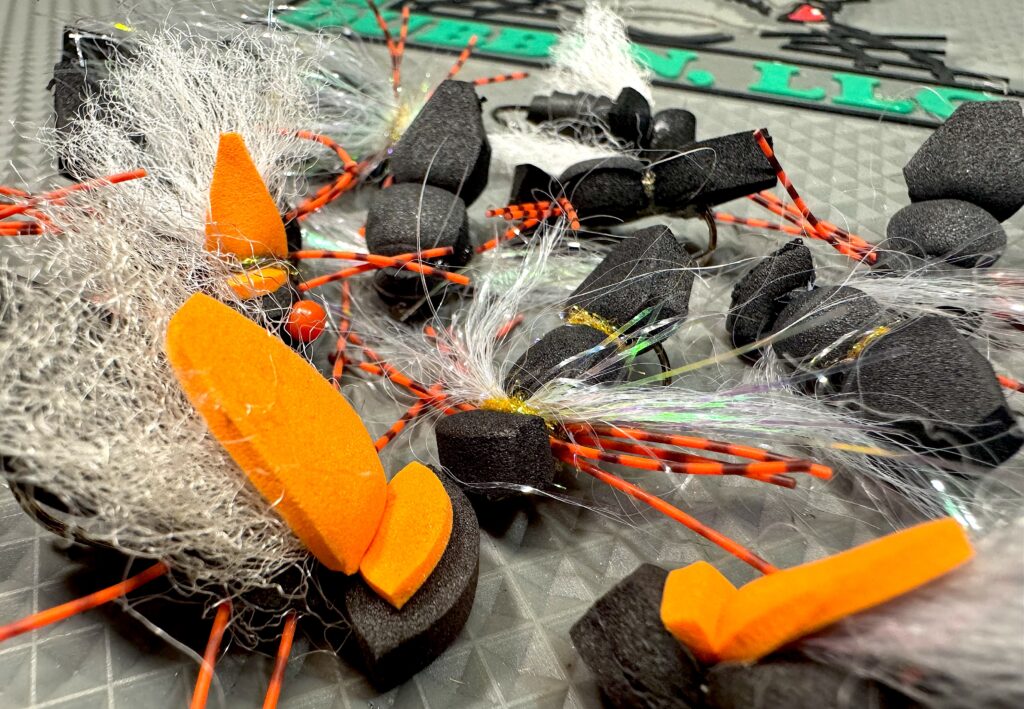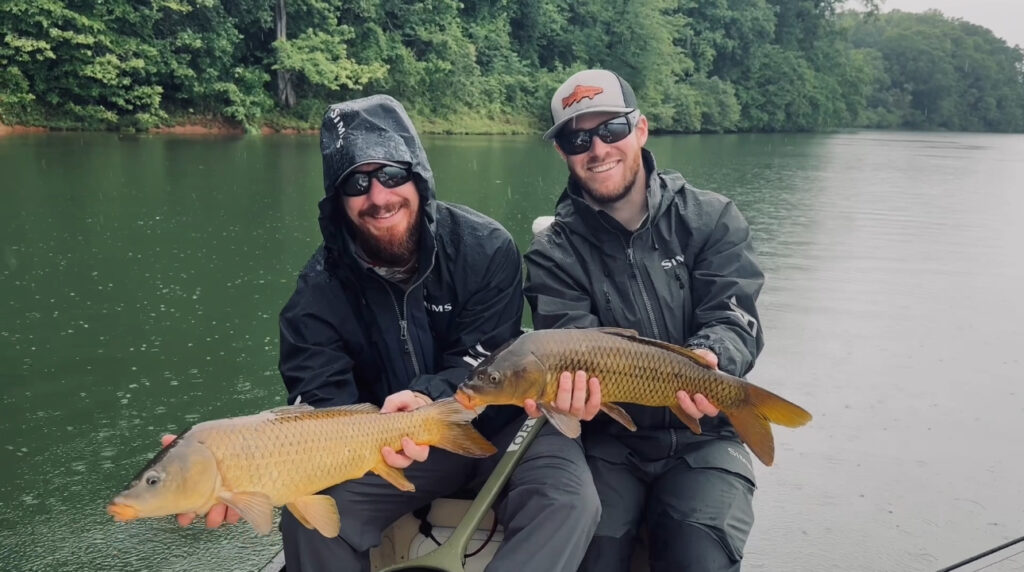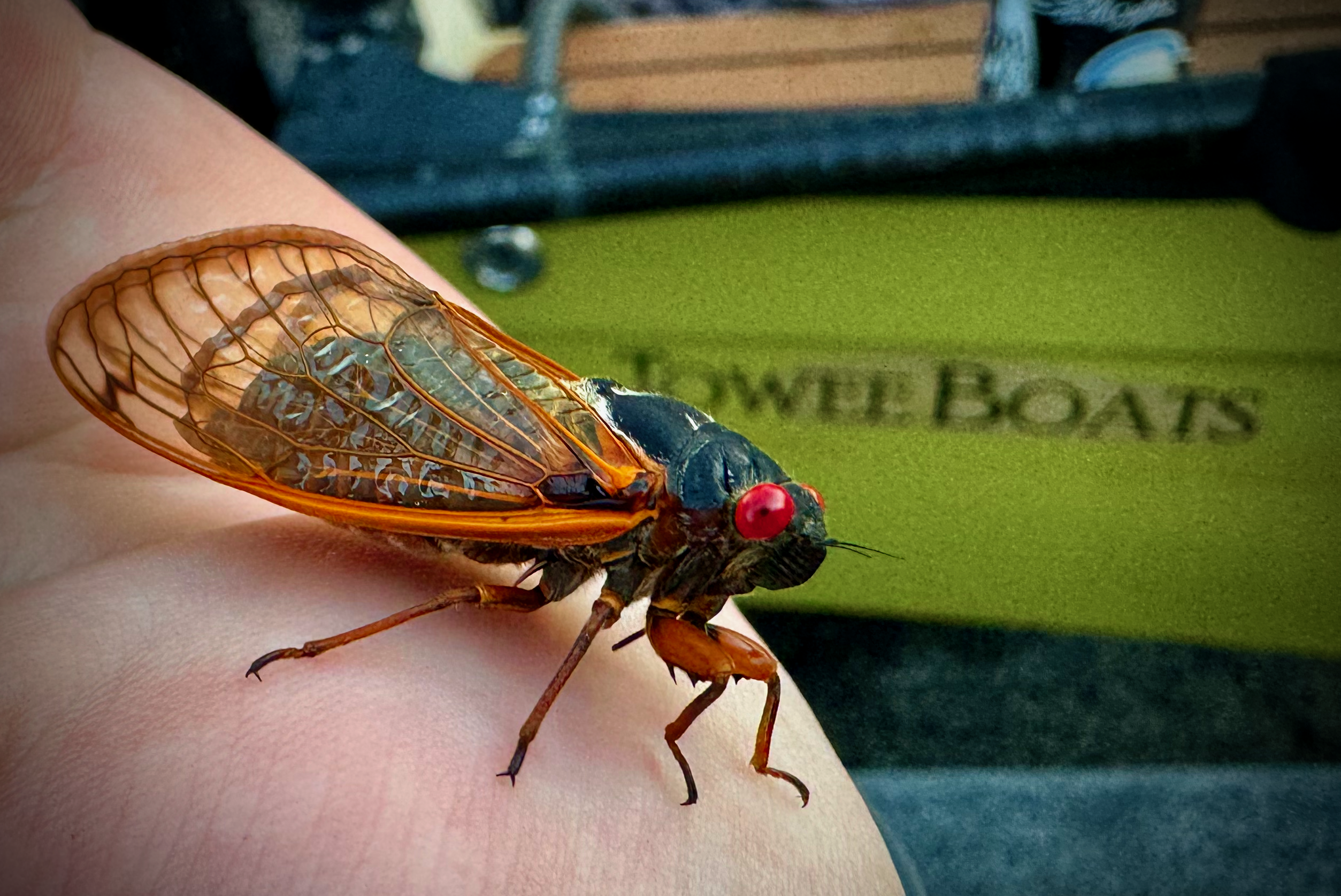There are few events in freshwater fishing as wild and rule breaking as a cicada hatch—and even fewer that involve targeting carp. I have been lucky enough to target carp in 2021, 2024, and 2025 during the cicada hatch, and it continues to be one of the most memorable angling experiences I’ve had. Giant bugs flying around like UFOs, hitting the water like hailstones, and big fish cruising just under the surface. It’s feels more like a trip to a golden corral than to a carp flat.
But, as exciting as it is, there are some misconceptions about fishing a cicada hatch for carp. Here’s what I have learned—and what might help you make the most of it when the bugs start buzzing in your area.
1. Don’t Be Early—But Be Ready
Most of us are conditioned to think that being early gets the worm. We wake up before dawn, get on the water early, and stay late. In the case of cicada hatches and carp, that couldn’t be further from the truth. The early days of a hatch are usually a bust for carp fishing.
Carp spend the majority of their lives living and feeding off the bottom. There is a reason a carps mouth is haphazardly slapped onto their chins, instead of out front like a bass, trout, or panfish. Even though they can feed on the surface—and do during cicada hatches—it takes them time to adjust. Their instincts don’t flip overnight. When we showed up early in 2021, the bugs were already abuzz, but the fish were nowhere to be found. But about a week later, the surface-feeding carp were present and active.

This goes for a given day too, being on the water early seldom is worth it. The cicadas become more active with the heat, and therefore so do the carp. Time on the water is always great, but don’t feel like you have to be the first boat at the ramp.
Don’t be too early with your hook sets either. Carp are poor surface feeders, and sometimes need a couple extra moments to get the fly into their mouths. Try to visualize the fish actually taking the fly into it’s mouth, instead of just looking for it to break the surface. Even knowing this, it always takes me a few missed fish on early hooksets before I get the hang of slowing down.
Takeaway:
- Don’t rush—carp need time to acclimate to topwater feeding.
- A 1–2 week delay can be the difference between empty water and a feeding frenzy.
- Keep your hooksets late too, carp are poor surface feeders
2. Forget Finesse—Bring the Splash
Our first approach was classic fly-fishing logic: long, delicate casts, subtle presentations. That worked okay—but the real turning point came when we started doing the opposite. Loud splats on the water, right in front of the fish, triggered aggressive reactions.
I began tying heavier cicada patterns with added lead or UV resin so they’d smack the surface hard. That “splat” acted like a dinner bell. A lot of times, if nothing happened in 10–15 seconds, we’d just recast. Blind casting didn’t help much—this was target fishing for visible cruisers.
If a carp turns off your fly or looses interest, sometimes a little wiggle with the rod tip will keep their interest. If not, pick up and recast- give them another chance at triggering a reactionary eat.
Takeaway:
- Loud, splashy casts outperformed delicate ones.
- Hit fish on the head—literally. Or at least near it and in front of them.
- Blind casting = low reward.
3. Ugly Flies Catch Fish Too
When we first started, we brought the good stuff—those meticulously tied, realistic cicada patterns. And they worked. But over time, we realized we were catching just as many fish on ugly, foam-and-thread monstrosities.

The key wasn’t realism, it was presentation, buoyancy, and splat. As long as your fly was roughly cicada-sized, floated well, and could splat loud, you were in business. That said, some patterns with splayed style wings seemed to draw more confident eats- but that might just be placebo.
Here’s what my favorite pattern looked like:
- 6mm Black foam body
- Orange Centipede rubber legs
- Flashy wing material for visibility
- Epoxy or UV resin base for weight and durability
Takeaway:
- Don’t overthink fly design—foam, legs, and buoyancy are king.
- Heavier flies that splat and float are key.
- Experiment with splayed wings for realism if desired.
4. Find the Bugs, Find the Fish
Cicadas don’t land evenly across a lake, nor are the necessarily distributed evenly in the forest. Cicadas lay their eggs in trees, so areas of lake surrounded by trees and forests definitely do better than more developed areas.

Wind pushes cicadas out of trees, and into coves, bays, and pockets—and that’s where the carp will be. You might find one area swarming with bugs and carp, while the next area over feels empty. The bugs, and the carp may be in windblown coves, but will oftentimes will be in coves the wind is blowing out from, because that means the wind is pushing the bugs out of trees and into the water
Take time to cruise with the trolling motor on high, observe, and find the water fish are in. These fish aren’t small, and neither are the bugs—they’re easy to spot once you’re in the zone.
Takeaway:
- Target areas where cicadas accumulate,
- Don’t waste time in low-bug zones.
- Be mobile and observant.
Final Thoughts
Fishing for carp on cicadas is a unique, unforgettable experience. It’s loud, visual, and oddly simple—if you let it be. Don’t be early. Don’t overthink your flies. Don’t tiptoe with your presentation. Just find the fish, make some noise, and have fun.
If the cicadas are coming to your area this year, and haven’t already left- carve out some time and go give it a shot. There’s nothing quite like watching a big carp eat a cicada fly like it’s the last little debbie on a week long fishing trip.

Leave a Reply